by Winding Pathways | Jul 29, 2016 | (Sub)Urban Homesteading, Flowers/Grasses, Nature, Reflections/Profiles, Wonderment
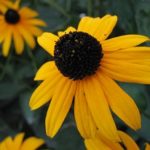
A brilliant harbinger of summer with a long lasting biannual bloom.
Many years ago word came that a dear friend had tragically died in Utah, over a thousand miles from our Iowa home. With deep feelings of grief of the loss of a vibrant young woman I (Rich) felt the need to “do something for her.”
We were in the process of restoring prairie to a bare patch of ground on recently purchased piece of land at the Indian Creek Nature Center. A bag of prairie wildflowers perched against my office wall caught my eye. I grabbed the bag, walked to the meadow and scattered the seeds in the woman’s honor.
The seeds thrived. Now, a dozen years later they grace the prairie with color and restore memories of my friend. We shared this story with our friend’s husband who was moved. So, we decided to share our way of honoring and memorializing ones dear to us.
Planting flowers, shrubs, and trees in a yard or park is an outstanding way to reduce grief, maintain memories, honor someone, and make our world healthier and more vibrant.
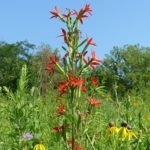
What a stunner!
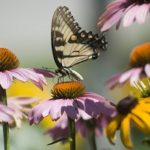
Sipping nectar
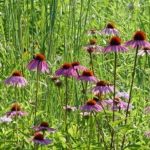
Purple Coneflowers add color to a prairie.
by Winding Pathways | Jul 26, 2016 | (Sub)Urban Homesteading, Flowers/Grasses, Garden/Yard, Nature, Reflections/Profiles, Wonderment
Periodically readers send lovely essays and observations of their Wondrous Yards. Below is a poetic piece by Katrina Garner.
“One of the benefits of creating and maintaining burn barriers around prairie areas is that the resulting “pathways” provide the perfect opportunity to observe the prairies from all sides. Every morning I head out with our Lab Schatzie for our long daily walk around the property, letting Schatzie choose our route. Sometimes she startles a deer, and sometimes a turkey blasts out of the grasses right in front of us. Schatzie holds on to the hope that one day she’ll actually catch one of the hundreds of rabbits who manage to stay just out of her reach. Always there’s a chorus of bird songs, blending together like a pastoral symphony, to remind me to focus on nature’s sounds.
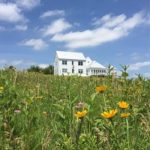
Capturing the essence of prairie blooms.
“I have my phone handy in case I see the perfect view for a future landscape painting. One day this past week we were ending the walk along the path between our first prairie planting and the pollinator strip next to it. The house was above us beyond the prairie. Our farm is named “Himmelhof,” a phrase coined by a friend of ours as an approximate Austrian translation for “House in the Heavens.” Seen from many points on the property, the house does seem to “float” above the prairie, and I’m particularly fond of those views of the house. At this point in our walk, the coneflowers and Black-eyed Susans were plentiful and at their peak, so I took out my phone and framed my photo to capture the “floating house” with colorful flowers in the foreground.
“A few days later, going through the recent photos on a larger computer screen, I was startled to see what looked like a ballerina with her arms raised to the heavens and her face turned towards the sun. If I wished to be pragmatic, I would acknowledge the fact that “she” was a cup-plant (Silphium perfoliatum) just masquerading as a fairy ballerina. However, the romantic in me chooses to see my prairie ballerina fairy as a joyful, whimsical reminder that I should always keep my mind and heart open to the beauty of the nature around me.
Katrina Garner, July, 2016″
Keep sharing about your lovely spaces, folks! Thanks, Katrina.
by Winding Pathways | Jul 5, 2016 | Bugs, Children/Play, Flowers/Grasses, Nature, Wonderment
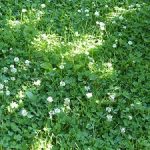
Soft and fragrant underfoot, clovers naturally fix nitrogen in our lawns.
A man whom Rich hadn’t seen for years recently approached him in a parking lot. “You once wrote a newspaper column suggesting that people not spray their yards for insects or weeds. We took your advice and magic happened,” he said.
He explained that a couple of years after he stopped spraying, white clover appeared in the yard and fireflies graced the evening darkness. “We’re enjoying both,” he added.
A major problem with poison sprays is that they aren’t usually selective. Often people spray to rid their lawn of grubs without realizing they also are killing fireflies, pollinators, and a host of other interesting and beneficial insects and the animals that dine on them. If you poison dandelions, you also kill clover that fixes nitrogen naturally and a wide range of other flowering plants that add diversity to the lawn and buffer it from unusual growing conditions.
FIREFLIES
What child has not delighted in chasing fireflies on a warm summer evening and, perhaps, catching a few to watch light up the inside of a glass jar? In fact, an adult friend who grew up on the eastern plains of Colorado was enchanted with them when she visited Iowa one summer. Fireflies, or lightning bugs, are common across much of the Eastern United States. Some blink yellow while others green, but whichever color they blink it is probably an effort to seek a mate. Some firefly species live in the West, they just don’t glow! The larvae, sometimes called glow worms often live in rotting wood where they seek insect prey.
To enjoy an evening firefly display leave edges and corners of your yards unmowed. Perhaps position some wood there to gradually rot and provide homes for their larvae. Certainly avoid insecticide spray!
CLOVER
Many species of clover are common across much of North America but the one most often found in unsprayed yards is the White Clover. It can be planted but usually just avoiding herbicides for a few years will encourage it to move in on its own. Clover blooms provide wonderful pollinator food while sprinkling a lawn with attractive white flowers. The plant is a legume, meaning that it is able to fix nitrogen and improve soil health – naturally! Why anyone would want to kill such a valuable and beautiful plant is beyond us.
Sometimes the very best lawn and yard management is simply leaving it alone. Stop spraying and the result is likely…….beauty.
by Winding Pathways | Aug 10, 2015 | Flowers/Grasses, Nature
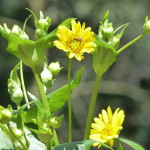
Late summer bloomers like cup Plant attract many pollinators.
One of the most interesting wildflowers has a long blooming season from mid-summer until early September and is host to a vast diversity of wildlife.
The Cup Plant (Silphium perfoliatum) gets its name from cups that form along the square stem of this large Silphium. Heavy dew and rain channel down leaves and stems to collect in the small cups of the leaves that gather around the stalks (perfoliatum) where birds and insects sip the moisture. This plant is nature’s watering hole, but it does even more to attract wildlife.
The showy flowers are sunflower-like and their brilliant color reflects the late summer hues of male goldfinches. This bird loves cup plants, where it drinks water, snacks on insects attracted to it and later in the fall eats the seeds. When in bloom cup plants are loaded with pollinators. Bumblebees and yellow and black swallowtail butterflies are frequent guests.
Cup plants live from the Great Plains east to the Atlantic and usually can be found in moist soil on the edge of woods. They thrive in yards but beware! This plant can grow to be ten feet tall. They are easily propagated from roots and tend to spread.
We have a big clump of cup plants near our back deck at Winding Pathways and enjoy watching a never ending stream of insects and birds visit the blooms. They are tall and block vision, so when the last seed is gleaned by an autumn goldfinch we cut down the stems but look forward to next year’s regrowth.
by Winding Pathways | May 24, 2015 | Flowers/Grasses, Nature
One of our favorite wildflowers at Winding Pathways is the purple coneflower. It’s named for petals that radiate backward in a cone shape. The genus name Echinacea means “hedgehog” in Greek and derives from the prickly seed head that forms in late summer and persists into winter.
Native to woods’ edges and clearings throughout Eastern North America it has been widely planted and is now common in natural areas and cultivated yards across the continent. There are many coneflower species but the purple is probably the best known. It’s a gorgeous plant that pollinators love, is in bloom for a long time, and is amazingly easy to grow in both formal and naturalistic plantings. Deer seem to leave them alone. Few wildflowers are as well suited to backyards, especially those that have some sun.
Many people claim medicinal value from Echinaceas, but scientific evidence is mixed and uncertain. Enjoy it for its beauty, ease of growing and pollinator benefit.
A simple and free way to establish this perennial is to is to glean seeds. Keep an eye out for blooming coneflowers this summer in places were collection is allowed and return in the fall. Wearing leather gloves rub the prickly heads between fingers into a bag to free the seeds. Then, immediately scatter them in appropriate places in your yards. Coneflowers love moist soil and partial to full sun.
Coneflower seed is readily available at garden stores, and many nurseries sell potted young plants. Usually purple coneflowers bloom the second growing season after planting and need little care.
Two of our favorite nurseries for plants native to the Midwest are Ion Exchange and Prairie Moon Nursery.
by Winding Pathways | Oct 1, 2014 | (Sub)Urban Homesteading, Flowers/Grasses, Garden/Yard, Nature, Trees/Shrubs
Clambering over the fallen branches of the cleared understory saplings, I realized I was pushing my way through a metaphor.
Recently, a dynamic work party gathered at Sand Ridge to access Faulkes Woods and begin rehabilitation of the diverse ecosystems that had inspired the dedication of this lovely preserve.
Soon after the 1998 dedication, Faulkes Woods Forest began to show degradation from previous years of little maintenance. Garlic mustard took over the ground cover. Barberry seeds, spread by birds, quickly colonized in huge inaccessible patches, crowding out all other vegetation. Shade-loving maples – some native, some European – prevented sun loving oak and hickory nuts from rooting. Food for wildlife became scarcer as quality habitat declined.
The prolific deer and turkey populations foraged in neighboring yards and gardens more frequently. Woodpeckers, finding the dying and dead trees just right for their food and shelter needs, had increased. Yet, other birds, such as the Ovenbird, that are typically found in large timber tracts seemed to have disappeared. According to the Cornell Laboratory of Ornithology under Habitat “Ovenbirds breed in large, mature broadleaf or mixed forests from the Mid-Atlantic states to northeastern British Columbia. They set up summer territories where the leaf canopy overhead inhibits underbrush and provides deep leaf litter hosting plenty of invertebrates.” This excerpt can explain why they are not around. Too much undesirable understory has prevented native plants from growing and leaf litter is practically non-existent. Erosion has increased.
The clearing out “work party” left the forest floor in shambles. At least that would be the first impression. Piles of barberry littered the bare forest floor. But, the rest of the area was free from large patches of impenetrable brush. The felled saplings were another story. Not only were they tough to climb over and push through, but also, they blocked the trail. So, newcomers to the forest could not tell if they were on the right path back to the house for lunch. Thank goodness for the bright orange marker tapes that the leaders had tied to trees along the way to point the way!
And, that is not all. This project has been in development for a number of months. Leadership centered on a core of reliable professionals from the City of Marion, Trees Forever, Iowa Natural Heritage Foundation, and Winding Pathways. Each knew his/her role. Everyone contributed positively. Volunteers, some experienced and some new to the efforts of ecological restoration, followed the lead of the crew chiefs. The project was successful because everyone made it so. And, deferred to experienced leaders.
All this hit me as I navigated the timbered jackstraw.
In short, a steady, decades-long and then rapid decline in quality with a huge mess to clean up.
So, the metaphor that popped into my mind as my way opened and the house loomed high on the ridge before me – still uphill – was, “This is a lot like church.”
Lacking regular attention to details over decades – finances, maintenance, staff and communications – and without a person truly “in charge” as a CEO by whatever name one gives this position, a church congregation can find itself overwhelmed by “garlic mustard, barberry, and invasive understory.” At a certain point a major “clearing out” needs to happen. But, it is messy, has far ranging consequences, hurts many people directly and indirectly involved, drives off productive families and may not be successful if it is only a superficial or “one time effort.”
The cultivation of steady maintenance and care of the physical plant, to social interactions, to nurturing of the tenets and principles to which a congregation espouses and spiritual development is necessary. Both professionals and volunteers need to participate. But, above all, someone must be in charge. And keep at it!
Finally, I pushed through the last of the maple branches and hiked up the trail to the house, washed up and prepared lunch for 27 wonderful volunteers and professionals who made a significant dent in stopping the woods’ degradation. Knowing that this was just the start of restoration, Rich has gone down periodically to trim back the branches from the fallen understory, the deer have eaten them back, the trail is open into the Woods and sunlight is beaming down onto the soil, warming it and the resting native ephemerals. The best part is that the Parks Department of Marion is very interested in the long term health of the Woods and that the sponsoring organizations’ leaders want to do more projects there.
The goals are clear and energy remains high. This is what restoration is about. May it be so in the church as well.







